#noel 1913
Text
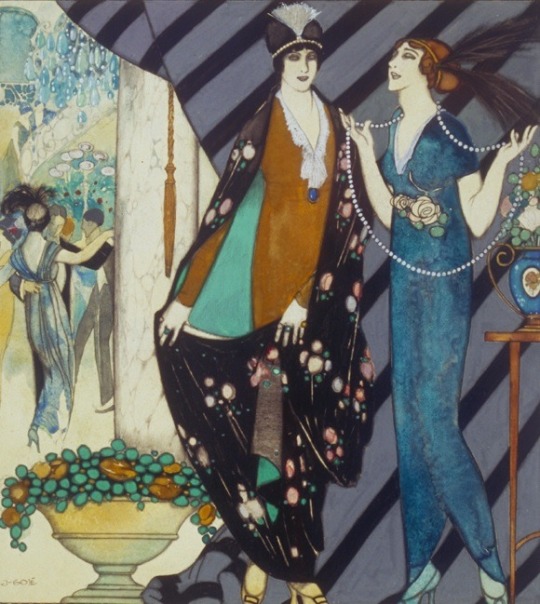
Xavier Gosé, Le Monde, High Life, Cover Illustration for Les Annales, Noel 1913.
Morera. Museu d'Art Modern i Contemporani, Carrer Major, 31, 25007 Lleida, Spain
#Francesc Xavier Gosé#Xavier Gosé#le monde#les annales#noel#noel 1913#1913#illustration#fashion illustration#art#spanish#spanish art#spanish illustration#1913 illustrations#high life#1910s fashion#1910s mode#1910s dresses#aigrette#edwardian#Edwardian era#la belle epoque#belle epoque#noel fashion#noel mode#antique#antique fashion#antique illustration#vintage#vintage fashion
34 notes
·
View notes
Text

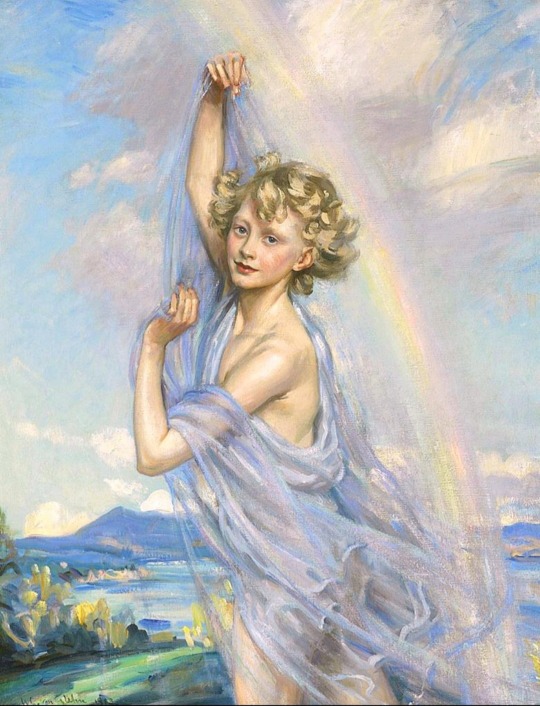

Wilfrid Gabriel de Glehn (British, 1870 - 1951):
1. Portrait of Mavis Yorke, ca. 1920.
2. Mavis Yorke dancing in 'Where the Rainbow Ends', 1913, oil on canvas, 44 × 34 inches.
3. Miss Mavis Yorke, child actress and dancer. Original photograph, pub. 1916.
"Celebrated as a child actress, Mavis Yorke made her debut in 1911 at the Savoy in 'Where the Rainbow Ends', a musical revue whose cast included a twelve-year-old Noel Coward, playing a naughty page boy. Later, Coward recalled Yorke as 'a fragile little thing... she played Will O' the Wisp and was exquisite; she flitted through the woods and glades of the production to Roger Quilter's gentle music and there was in her a quality of magic'. (See N. Coward, Present Indicative, p. 27.)"
"De Glehn painted her as Will o'the Wisp in 1913, and again, seven years later in the present portrait."
4 notes
·
View notes
Text
2 notes
·
View notes
Text
'David Tennant and Catherine Tate return to "Doctor Who" on Saturday for the first of three special episodes to celebrate the show's 60th anniversary.
The hit series follows the adventures of an alien Time Lord, The Doctor, on his adventures through time and space, and his battles with villains including Daleks, Cybermen, and The Master.
"Doctor Who" first began airing in 1963 and has been running for 60 years on the BBC, though it took a hiatus in 1989.
In 2005, the series was relaunched with Christopher Eccleston as the Ninth Doctor.
When Eccleston's Doctor regenerated — a physical transformation that essentially allows for the lead role to be recast — at the end of season one, he morphed into David Tennant, who was the Tenth Doctor and will return to the role to mark the 60th anniversary...
10. "Journey's End" (Season 4, Episode 13)
Average fan rating: 9.2/10
What happens: Before Marvel's "Avengers," "Doctor Who" had its own superstar crossover episode.
"Journey's End" brought together the Tenth Doctor (Tennant), every companion from the relaunch to date, and characters from the spinoff series "Torchwood" and "The Sarah Jane Adventures," to face the villain Davros.
In the episode, Davros and an army of Daleks threaten to wipe out the entire universe, forcing the Doctor and his allies to try to save the day, and Earth. (This was the second installment in a two-part episode.)
The episode was Donna Noble's (Tate) last as the Doctor's main companion, though Tate has made a few appearances since.
9. "The Family of Blood" (Season 3, Episode 9)
Average fan rating: 9.2/10
What happens: To avoid a group of aliens that want to feed on his Time Lord essence, the Doctor (Tennant) turns himself human and hides in 1913 England. However, the aliens track him down, and his companion Martha (Freema Agyeman) tries to get the Doctor to restore his memories. (This was the second installment in a two-part episode.)
8. "Doomsday" (Season 2, Episode 13)
Average fan rating: 9.2/10
What happens: The Doctor faces off against two of his greatest rivals, the Daleks and the Cybermen. The Doctor (Tennant) and his allies have to defeat both enemies to save Earth. (This was the second installment in a two-part episode.)
This was a sad episode for many fans since it was Rose Tyler's (Billie Piper) last as the Doctor's main companion. Piper has made a few appearances since.
7. "The Girl in the Fireplace" (Season 2, Episode 4)
Average fan rating: 9.2/10
What happens: The Doctor (Tennant) and his companions, Mickey (Noel Clarke) and Rose (Piper), stumble upon an abandoned spaceship that can transport people to 18th-century France, and discover an alien plot involving Madame de Pompadour (Sophia Myles), a famous mistress of King Louis XV. The trio tries to save her from a group of clockwork androids.
6. "Silence in the Library" (Season 4, Episode 8)
Average fan rating: 9.3/10
What happens: The Doctor (Tennant) and Donna (Tate) visit a seemingly empty planet-sized library in the 51st century. A team of researchers including River Song (Alex Kingston), a mysterious time traveler from the Doctor's future, soon arrive. The Doctor and team discover a swarm of vicious aliens that can imitate shadows. (This was the first installment in a two-part episode.)...
4. "The Day of the Doctor" (50th anniversary special)
Average fan rating: 9.3/10
What happens: To mark the 50th anniversary of "Doctor Who" in 2013, the BBC aired a special episode featuring multiple Doctors.
Jumping back in time to the fall of Gallifrey, the Doctor's home planet, the War Doctor (John Hurt) prepares to destroy his home in order to save the universe. and end the Time War between the Daleks and the Time Lords.
In the present, the Tenth (Tennant) and Eleventh (Smith) Doctors work together to stop a secret organization from destroying Earth.
The Fourth Doctor (Tom Baker) and the Twelfth Doctor (Peter Capaldi) also make appearances, while archive footage is used to show the other Doctors.
3. "Forest of the Dead" (Season 4, Episode 9)
Average fan rating: 9.4/10
What happens: In the followup to "Silence in the Library," the Doctor (Tennant), Donna (Tate), River Song (Kingston), and a group of researchers try to survive being hunted by a swarm of deadly aliens called the Vashta Nerada. (This was the second installment in a two-part episode.)...
1. "Blink" (Season 3, Episode 10)
Average fan rating: 9.8/10
What happens: Sally Sparrow (Carey Mulligan) discovers that she is being haunted by statues. In order to save the Doctor (Tennant), the universe, and herself, she has to learn how to defeat a group of dangerous aliens called the Weeping Angels.'
#Blink#Forest of the Dead#Silence in the Library#The Day of the Doctor#The Girl in the Fireplace#Sally Sparrow#Carey Mulligan#David Tennant#Catherine Tate#Alex Kingston#River Song#Peter Capaldi#Tom Baker#Matt Smith#Jenna Coleman#Clara#Madame de Pompadour#Sophia Myles#Mickey Smith#Noel Clarke#Doomsday#Rose Tyler#Billie Piper#The Family of Blood#Martha Jones#Freema Agyeman#Journey's End#John Barrowman#Captain Jack Harkness#Elisabeth Sladen
5 notes
·
View notes
Text




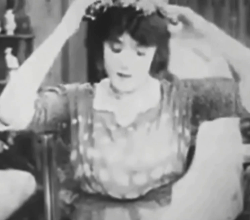




A Submarine Pirate (1915) / Willful Ambrose (1915) / Bombs! (1916) / The Feathered Nest (1916) / Her Torpedoed Love (1917) / Hearts and Flowers (1919) / Down on the Farm (1920)
From her Keystone debut in 1915 to her last First National comedy in 1922, Fazenda was one of Sennett's top comedy stars—appearing in nearly 60 Sennett shorts and features during that time.
Fazenda became familiar audiences as the hayseed girl who was forever falling prey to the shifty city slicker or evil mortgage holder, with her spit curl, ribbon-tied pigtails and calico dress. Just as often, she was the hard-working blue-collar girl who would leave her dreary job as a waitress or maid to collect a healthy inheritance—pursued by the usual assortment of Sennett fortune hunters. With hazel eyes and light brown hair, Fazenda could just as easily put on a blonde wig and play attractive, vampish roles.
Born in Lafayette, Indiana, the daughter of a Mexican-born grocer and American-born mother, Fazenda's family moved to LA by 1900—where she attended Los Angeles High School and St. Mary's Convent. She debuted in dramatic stock with Miss Del Valle in LA and later appeared with Virginia Brissac. Louise got her start in films at Universal in 1912 under the direction of Wilfred Lucas, but by 1913 was appearing alongside Max Asher, Harry McCoy, Bobby Vernon, Gale Henry, Lee Morris, Billy Franey, Heinie Conklin and the other featured players in Universal's Joker Comedies.
When her Sennett contract ended in Sep 1920, Fazenda joined Special Pictures Corp. briefly in late 1920; then she appeared in a trio of California Producers Corp.'s Punch Comedies (1921) co-starring Chester Conklin and John Henry Jr. That came before a brief return to Sennett for a couple of appearances during 1921-22. Fazenda starred in some of Jack White's Mermaid Comedies (1923-24) before settling into roles in features. With the coming of sound, Louise returned to shorts for Christie (1929) and Darmour (1930). She continued with feature support in films. Fazenda found a second home at Warner Brothers, becoming a familiar character face in musicals.
On March 7, 1919, Fazenda married Sennett director Noel M. Smith, to whom she'd been engaged since 1917; they separated on August 14, 1923, and divorced on August 1, 1926. On November 24, 1927 she married Warner Bros. publicity director Hal B. Wallis, soon to became Warners' studio manager and then a long-time film producer. Fazenda retired from the screen in 1939, and remained married to Wallis until her death at 66 in Beverly Hills of a cerebral hemorrhage, leaving Wallis and son Brent. She is interred at Inglewood Park Cemetery, Inglewood, California.
-Walker, B.E., 2010, Mack Sennett's Fun Factory, McFarland&Company, Inc., Publishers, pp. 502~504
#louise fazenda#a submarine pirate 1915#willful ambrose 1915#bombs! 1916#the feathered nest 1916#her torpedoed love 1917#hearts and flowers 1919#down on the farm 1920#책 인용
5 notes
·
View notes
Note
1908 - Tomasz Marek (Nr. 3)
1912 - Lauri Kinet (Nr. 1)
1913 - Noel Kaiser (Nr. 2) (eight months after Lauri)
1917 - Dio Hamirez (Nr. 4)
July 1918 - Raisa Amosova (Nr. 7)
9th of March 1920 - Kierra Thier (Nr. 9)
1960s - Iva Ruben (Nr. 6)
Hm... if it's one of them, it's gotta be either Raisa or Dio...
3 notes
·
View notes
Text


Lionel Noel Royer - Scène De La Vie De Jeanne D'Arc, 1913.
2 notes
·
View notes
Note
Tell us more…? 👀
I still have to sort through the information a bit, but I can give you the names; tell me which one you want to hear about first. :]
1. Lauri Kinet, 1888 - 1912; marksman for what would later become MTF-Delta-14 "Winter Wonderland".
2. Noel Kaiser, 1890-1913; Agent for the first Iteration of MTF-Epsilon-9 "Village Idiots".
3. Tomasz Marek, 1886 - 1908; Researcher who discovered and worked with SCP-049.
4. Dionisia "Dio" Hamirez, 1892 - 1917; Researcher who primarily worked with SCP-035.
5. Willow Khater, 1894 onward; trauma surgeon.
6. Iva Ruben, 1892 onward; Researcher who primarily worked with SCP-590.
7. Raisa Amosova, 1895 - 1918; pilot for MTF-Nu-7 "Hammer Down" and Russian fighter ace.
8. Samuel Roberts, 1898 onward; explosives specialist for a naval unit of MTF-Epsilon-9 "Fire Eaters".
9. Kierra Thier, 1900 - 1920; medic specialized in anomalous injuries.
3 notes
·
View notes
Photo

Ronald Colman in The Prisoner of Zenda (John Cromwell, 1937)
Cast: Ronald Colman, Madeleine Carroll, C. Aubrey Smith, Raymond Massey, Mary Astor, David Niven, Douglas Fairbanks Jr. Screenplay: John L. Balderston, Edward E. Rose, Wells Root, Donald Ogden Stewart, based on a novel by Anthony Hope. Cinematography: James Wong Howe. Art direction: Lyle R. Wheeler. Film editing: James E. Newcom. Music: Arnold Newman.
The identical cousin is a genetic anomaly known only to Anthony Hope and the creators of The Patty Duke Show, but both got a great deal of mileage out of it. Hope's novel about a man who finds himself posing as a Ruritanian king to fend off a threat to the throne was such a hit that it was immediately adapted for the stage, turned into a film in 1913, and even became a Sigmund Romberg operetta. But leave it to David O. Selznick to produce perhaps the best of all adaptations. It was once said of Selznick -- I forget by whom, but it sounds a lot like something Ben Hecht would say -- that to judge from his movies, he had read nothing past the age of 12. Among the novels he made into movies are David Copperfield (George Cukor, 1935), A Tale of Two Cities (Jack Conway, 1935), Little Lord Fauntleroy (John Cromwell, 1936), and The Adventures of Tom Sawyer (Norman Taurog, 1938). But it has to be said that each of these adaptations remains probably the best screen version of its source. The 1937 Prisoner of Zenda is so good that when MGM decided to remake it in Technicolor in 1952, producer Pandro S. Berman and director Richard Thorpe not only used the 1937 screenplay by John Balderston and Noel Langley, with Donald Ogden Stewart's punched-up dialogue, but also the score by Alfred Newman, following the earlier version almost shot for shot. The chief virtue of Selznick's production lies in its casting: Ronald Colman is suave and dashing as Rudolf Rassendyll and his royal double, Madeleine Carroll makes a radiant Princess Flavia, and Raymond Massey is a saturnine Black Michael. Mary Astor, C. Aubrey Smith, and David Niven steal scenes right and left. Best of all, though, is Douglas Fairbanks Jr. as Rupert von Hentzau, a grinning scamp of a villain. Fairbanks is so good in the role that we cheer when he escapes at the end. How Selznick got this one past the Production Code, which usually insisted on punishing wrongdoers. is a bit of a mystery, but he may have told the censors that he was planning to film Hope's sequel, Rupert of Hentzau, in which Rupert gets what's coming to him. He never got around to the sequel, of course, being distracted by Gone With the Wind (Victor Fleming, 1939).
1 note
·
View note
Text






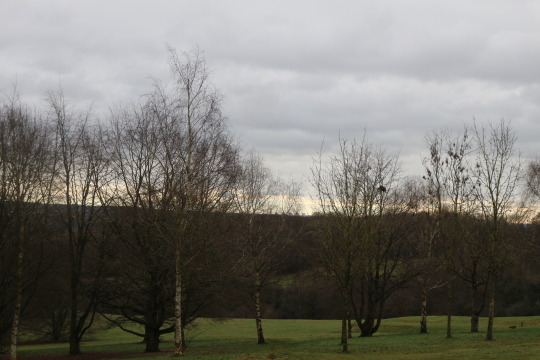




Your vigorous youth with upright shoots,
Your verdant age, your glowing fruits,
Your glossy leaves, and columns gray
Shall live the favorites of my lay! Francis Noel Clarke Mundy.
Allestree Hall was owned by the Mundy family, who also owned Markeaton, from 1516 until 1781, when Francis Noel Clarke Mundy sold to Thomas Evans, an industrialist who worked at Darley Abbey.
It part of a chain of country houses (I went to both Darley, Markeaton, Allestree and Kedleston in a single day’s walking, albeit a long one), proving right Daniel Defoe’s claim that “This is a fine, beautiful, and pleasant town; it has more families of gentlemen in it than is usual in towns so remote, and therefore here is a great deal of good and some gay company”
The Evans family, who also (from 1812) owned Boscobel, Staffordshire, set themselves up as country gentlemen and William Evans’ son Thomas Willam Evans became a Member of Parliament at the same time as his neighbour George Nathaniel Curzon, from Kedleston (please see here for that fine house, whicch I went to on the same day) albeit the Evanses were Liberals and the Curzons were Tories.
After Thomas died childless in 1892, the estate was left to his nephew William Gisborne, who lived here full-time for six years; Gisborne’s son Lionel inherited on William Gisborne’s death in 1898, but had little interest in the house and rented it to Herbert Raphael, a businessman and fellow Liberal politician.
Raphael was evicted in 1913 (he went on to fight with distinction in World War 1, rising from private to major) because Lionel wanted to sell to Colonel Herbert Johnson. Johnson died in 1923 and his wife Ethyl in 1928; after this, there were no more full-time residents.
Like many country houses, Allestree span through different uses but none stuck; the home of a building company, a fire service, a golf course (1947- extended in 1955), and a planned museum (Derby city council, which had owned the site since 1946, tried to set this up in the 1980s but it never happened), and a park, which it still is.
Excitingly, the golf course shut down in 2020 (I have never had any time for golf) and a new rewilding project is underway; my first visit was in (2,6,9) August 2022 and it is, as you can see, changing in unpredictable ways so I don't know what I'lll find on my next visit, except that it will be good.
It’s now possible to start along the River Derwent, through Darley, and barely see a road before striding into Allestree (it’s easy to see why the Evanses wanted to join up their holdings) and this is what I look forward to doing again as I see what leaps forward nature has taken as the rewilding joyfully spins out of the control of the tidy-minded men who think golf is a good idea.
1 note
·
View note
Text
Birthdays 12.25
Beer Birthdays
Stephan Moninger (1827)
Adam Eulberg (1855)
Curtis Cassidy (1985)
Five Favorite Birthdays
Humphrey Bogart; actor (1899)
Cab Calloway; jazz singer, bandleader (1907)
Annie Lennox; pop singer (1954)
Isaac Newton; English scientist (1642)
Rod Serling; writer (1924)
Famous Birthdays
Clara Barton; humanitarian, Red Cross founder (1821)
Jimmy Buffett; pop singer (1946)
Robin Campbell; rock guuitarist, singer (1954)
Carlos Castaneda; anthropologist, writer (1931)
Helena Christensen; Danish model (1968)
Quentin Crisp; wit, writer (1908)
Larry Csonka; Miami Dolphins RB (1946)
Dido; Australian pop singer (1971)
Kenny Everett; English comedian (1944)
Doug Ferrari; comedian (1956)
Lew Grade; television producer (1906)
Rickey Henderson; Oakland A's LF (1958)
Conrad Hilton; hotelier (1887)
Barbara Mandrell; country singer (1948)
Tony Martin; singer (1913)
Irish McCalla; actor (1929)
Alannah Myles; pop singer, songwriter (1958)
Evelyn Nesbit; model (1884)
Kid Ory; jazz trombonist, bandleader (1886)
Noel Redding; rock bassist (1945)
Robert L. Ripley; cartoonist (1893)
Karl Rove; political wing nut, psychopath (1950)
Pete Rugolo; jazz arranger, bandleader (1915)
Helena Rubenstein; make-up maker (1870)
Saladin; Egyptian, Syrian sultan (1137)
Sissy Spacek; actor (1949)
Ken Stabler; Oakland Raiders QB (1945)
1 note
·
View note
Text

"THE CHARGE AGAINST STAFFORD DISMISSED," Edmonton Bulletin. March 14, 1913. Page 7.
---
Detective Who Conducted Edson Clean-up Is Discharged By Judge Who Tried Charge of Unlawfully Wounding.
---
With honors thick upon him, in the shape of a cheque for $300 voted him by the Edson city council for his services in clearing up the city by his recent crusade as temporary chief constable, and with the charge against him of unlawfully wounding M. Nibdock, dismissed yesterday afternoon by Judge Noel Detective Richard Stafford returned to the city this morning. Judge Noel disposed of the case without much delay and after the prosecution had called four witnesses declared that it was needless to call further witnesses, for he must dismiss the charge againt Detective Stafford.
Judge Noel declared that at the time the affair took place Stafford was acting in his official capacity as chief of the Edson police, and that if he had actually shot Henry or Niblock in the execution of his duty he would not have been criminally liable.
The case had been called for 10 in the morning, but on the court opening at that hour the necessary conmittal papers could not be found, and it was learned that J. Bradley, J.P., who issued the warrant and had charge of the papers, was out of town. Judge Noel said he could not try the case, as there was no charge against Stafford. Bradley, it was stated, had left the papers with W. Fulmer, J.J., but Fulmer denied all knowledge of this. So Judge Noel adjourned to 2 p.m.
At 2 o'clock all papers were there, and witnesses present. Mr. M. W. Eagar appeared for the crown to prosecute, L. W. Brown for the defence, Mr. Roberts, of Edson, objected to Stafford's being tried, saying he was not properly before court, as he claimed the only magistrate who could commit was the one who took the preliminary hearing, adding that he was not briefed in the Mr. Eagar wanted to know why Mr. Roberts was speaking if he were not briefed.
Judge Noel ruled that all was in order and that he would proceed with the case. Four witnesses were called for the prosecution.
At the close, L W. Brown, who defended, asked for the accused's discharge, saying that there was no case against him. Judge Noel then said he would like to hear Detective Stafford's version of the case, and after this had been given, Judge Noel said that there was no need to call further witnesses for the defence and that he would be discharged.
#edson alberta#edmonton#police shooting#private detective#police powers#police violence#municipal politics#canadian judicary#incompetent judges#crime and punishment in canada#history of crime and punishment in canada
0 notes
Text
Giorgio De Chirico, Metafisica continua a Conegliano
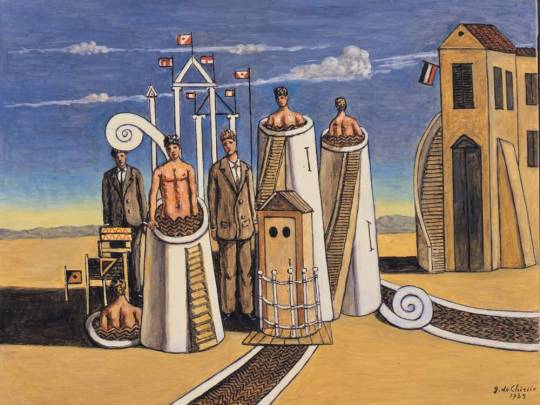
La mostra Giorgio de Chirico. Metafisica continua, allestita a Conegliano, in provincia di Treviso, presso Palazzo Sarcinelli fino al 25 febbraio 2024, anticipa le celebrazioni del centenario del Surrealismo (1924-2024), movimento di cui de Chirico fu, a sua insaputa, capostipite, come disse il fondatore André Breton.
Infatti, come per altri surrealisti quali Max Ernst, René Magritte, Yves Tanguy e Salvador Dalì, la prima pittura metafisica (1910-1918) di de Chirico svolse un ruolo fondamentale nello sviluppo del movimento dall’inizio degli anni Venti in poi.
A cura di Victoria Noel-Johnson, la mostra è organizzata da ARTIKA di Daniel Buso ed Elena Zannoni, in collaborazione con Fondazione Giorgio e Isa de Chirico e il Comune di Conegliano, con 71 opere dell’artista e tra esse un’importante selezione dei principali soggetti di de Chirico, tra cui i Manichini senza volto e i Trovatori, le Piazze d’Italia e le Torri, gli Interni ferraresi, i Trofei, i Gladiatori, gli Archeologi, i Soli accesi e spenti e i Bagnanti misteriosi del 1934.
Un ampio focus nella mostra è riservato alla stagione neometafisica (1965-1978) di cui La Fondazione de Chirico possiede la più importante e completa collezione al mondo, dove l’artista tornò a elaborare i temi che popolavano le opere del primo periodo metafisico (1910-1918).
Oltre a presentare i motivi più noti, i prestiti fanno notare la gamma di tecniche in cui si è cimentato il maestro: pittura, disegno, acquerello, scultura e litografia.
Come ormai ampiamente riconosciuto dalla critica, tutti questi lavori sono considerati metafisici, in quanto sostenuti dal costante interesse di de Chirico per i due concetti nietzschiani dell’eterno ritorno e del dualismo apollineo - dionisiaco.
Una delle figure principali dell’arte del primo Novecento, de Chirico ha influenzato in modo profondo non solo il surrealismo, ma anche altri movimenti di ampio respiro, tra cui il dadaismo, il realismo magico, la Neue Sachlichkeit (nuova oggettività), la pop art, la transavanguardia e alcuni aspetti del postmodernismo.
A ciò ha contribuito la volontà di sperimentazione dell’artista, che nei suoi settant’anni di carriera (1908-1978) non ha mai smesso di elaborare stili, tecniche, soggetti e colori diversi, in modo non dissimile dal coetaneo Picasso.
La natura apparentemente paradossale dell’opera di de Chirico è, per l’appunto, ciò che la rende ancor oggi così attuale per gli artisti e il pubblico moderno.
Promossi per la prima volta nel 1913 da Apollinaire e Picasso, i primi dipinti di de Chirico furono un “canto nuovo” che affascinò e, in parte, galvanizzò l’avanguardia parigina degli anni Dieci, seguita dai surrealisti negli anni Venti.
Read the full article
1 note
·
View note
Text

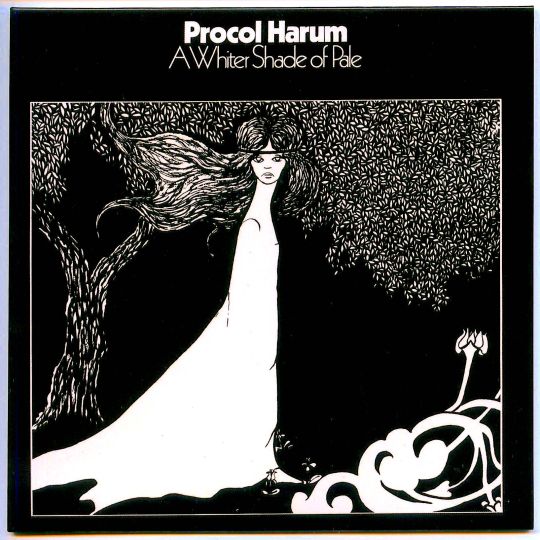


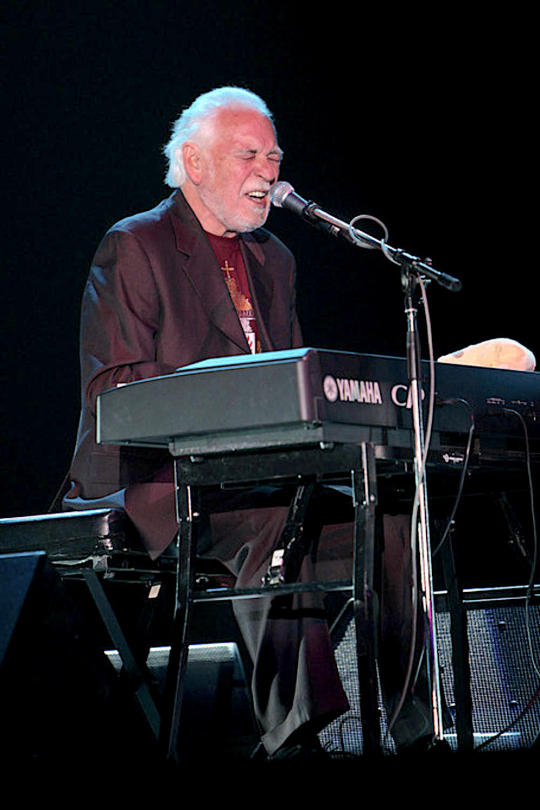

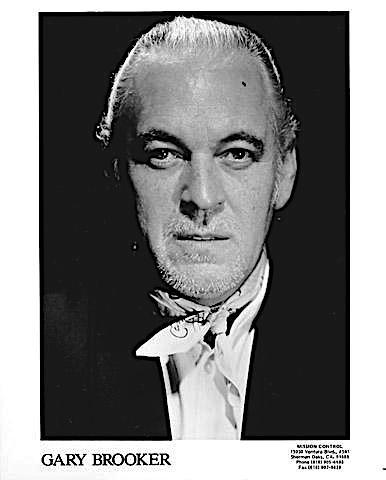

HAPPY BIRTHDAY to Isaac Albéniz, Per "Howlin' Pelle" Almqvist (The Hives), Mel B, Annette Bening, Johnny Cash’s 1976 single “One Piece at a Time,” Kato Cephus, G.K. Chesterton, Roy Crewdson (Freddie & the Dreamers), Karla DeVito, Danny Elfman, The Everly Brothers 1960 single “Cathy’s Clown,” Noel Gallagher (good to have met you), Mel Gaynor (Simple Minds), Haydn’s 1753 opera “The Limping Devil,” Valy Hedjasi, Bob Hope, LaToya Jackson, John F. Kennedy, Ted Levine, Sylvester Magee, Karl Münchinger, David Palmer (ABC), Adrian Paul, Mike Porcaro, Freddie Redd, Sylvia Robinson, Francis Rossi (Status Quo), Schoenberg’s 1956 “Modern Psalm,” Carl Story, Stravinsky’s riotous 1913 ballet “The Rite of Spring,” Mitch Taylor, Sojourner Truth’s “Ain’t I A Woman?” speech (1851), The Waitresses 1982 single “I Know What Boys Like,” Randall Woodfin, bassist "The Senator" Eugene Wright, Iannis Xenakis, and one of my heroes, the great keyboardist, singer-songwriter, co-founder of Procol Harum and sidearm to Eric Clapton and George Harrison: Gary Brooker. His solo albums + Procol Harum albums have been with me since they were new, and I’ve covered a few of their songs (I love doing “Whiskey Train”). Elsewhere in my orbit, The Davy Jones Band did a share-bill with Procol Harum, and everyone raved about their set. Gary’s 1982 album LEAD ME TO THE WATER partially inspired my first album DOOR IN THE WATER. Here’s a recently-made and marvelous cover of PH’s signature hit, “A Whiter Shade of Pale,” performed by my pals down at the studio, Chris von Sneidern & Friends:
#garybrooker #procolharum #chrisvonsneidern #prairieprince #tapevaultstudio #sanfrancisco #birthday #pale #classicrock #britishrock
#johnny j blair#singer songwriter#music#pop rock#Gary Brooker#Procol Harum#Chris von Sneidern#Prairie Prince#Tape Vault Studio#San Francisco#birthday#pale#classic rock#british rock#Bandcamp
1 note
·
View note
Text
Yuletidings 2012: Yuletide Long Ago

1. Santa Claus Hides in the Phonograph (excerpt) – Ernest Hare (1922)
2. Parade of the Wooden Soldiers – Paul Whiteman and His Orch. (1923)
3. Christmas, Christmas, Blessed, Blessed Day - The Metropolitan Quartet (1917)
4. Noel Holy Night (O Holy Night) – The Venetian Trio (1916)
5. On a Good Old-Time Sleigh Ride – The Peerless Quartet (1913)
6. Christmas Bells – Robert Gayler (1919)
7. Chinese Dance/Dance of the Mirilitons from The Nutcracker – The Victor Herbert Orch. (1913)
8. Bells of Christmas – The Edison Concert Band (1913)
9. Scrooge’s Awakening (excerpt) – Albert Whelan (1904)
10. Christmas Carol Medley – The Collegiate Choir (1924)
11. Christmas Hymns – Francis J. Lapitino (1917)
12. Snow Time – The Columbia Quartet (1911)
13. Santa Claus Hides in the Phonograph (excerpt 2) – Ernest Hare (1922)
14. Jingle Bells – The Shannon Quartet (1925)
15. Silent Night, Hallowed Night – The Hayden Quartet (1909)
----------------------------------------
This collection has always been a favorite of mine. It consists entirely of holiday music recorded between 1900 and the early 1920's, transferred from shellac discs and even wax cylinders.
There's something both charming and melancholy about hearing these voices and instruments across such a distance of years, something about the spirits of the people making the music, as well as their styles of playing and singing, which really bring that vanished era to life.
Imagine a time when recorded sound was still such a novelty that an actor pretending to be Santa Claus could convince children that he was literally hiding inside the Victrola. Consider the fact that the 1913 excerpt from The Nutcracker included here was recorded just twenty years after Tchaikovsky’s death in 1893. (He lived to see the dawn of the Recording Era - in fact, there’s a wax cylinder recording of his voice from 1890 - but not long enough to hear the first recording of his work, which was in 1909.) Or that the excerpt from ‘A Christmas Carol’ included here was recorded in 1909, less than four decades after the death of Charles Dickens.
I especially love the exuberance of the Metropolitan Quartet singing “Christmas, Christmas, Blessed, Blessed Day” and of the Peerless Quartet’s “On a Good Old-Time Sleigh Ride”; also the beautifully arranged and played “O Holy Night” (Titled “Noel Holy Night”) by the Venetian Trio.
The first recording of “Jingle Bells” was made in 1889, though no surviving copies are known to exist. This 1925 version by the Shannon Quartet, however, is quite charming with its barbershop harmonies.
These recordings are all noisy and scratchy and I think it’s part of their charm.
The cover art is a Victorian-era Christmas card to which I added the title.
DOWNLOAD
0 notes